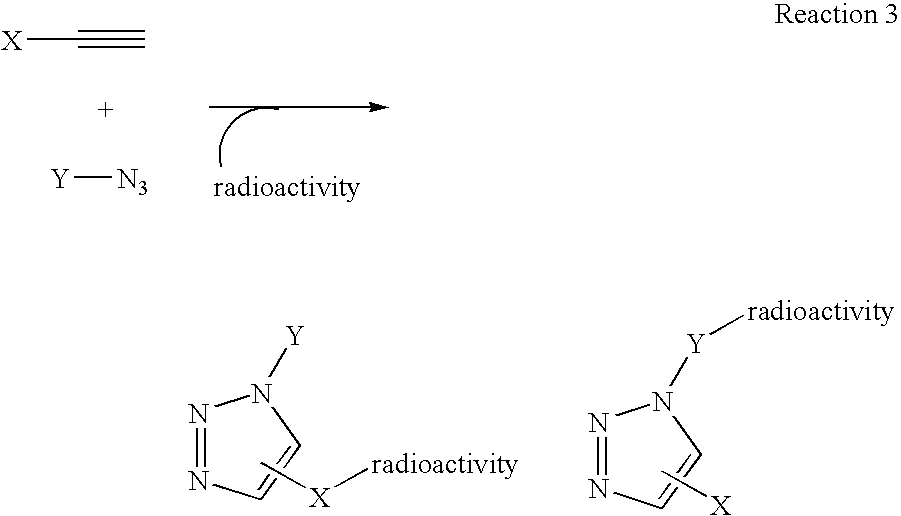Click chemistry method for synthesizing molecular imaging probes
a molecular imaging and click chemistry technology, applied in the field of click chemistry methods for preparing high affinity molecular imaging probes, can solve the problems of limiting the specificity of fdg-pet imaging for monitoring cancer, limiting the sensitivity of pet for tumor response prediction, and accumulation in inflammatory tissue, so as to achieve high reaction specificity
- Summary
- Abstract
- Description
- Claims
- Application Information
AI Technical Summary
Benefits of technology
Problems solved by technology
Method used
Image
Examples
examples
[0067]
[0068] FIG. 2.
[0069] Another variation on the labeling theme would be to first react the azide and the alkyne, in this example the alkylazide bears a leaving group, to form triazole followed by displacement of the leaving group with 18F-fluoride (Scheme II).
[0070] This method of labeling is also ideally suited for labeling of biomacromolecules with radioisotopes. The reactive precursor that is reacted with the radioactive precursor or “tag” can also be any of various disease-related biomolecules, including proteins, carbohydrates, and the like. Any molecule of biological utility that can be chemically modified to include a click chemistry reactive group, such as an azide or an alkynyl group, can be used as the reactive precursor without departing from the present invention. The radioactive precursor is first synthesized and then coupled in aqueous buffer media in the presence of copper (I) salts to afford triazole formation.
[0071] The first reactive precursor is reacted w...
example
Synthesis of 3′-deoxy-3′-[(4-[18F]fluoromethyl)-[1,2,3]triazole]thymidine
[0131]
Click In-Situ 2-Step F-18 3′-Triazole Experimental
[0132] Oxygen-18 water (>97% enriched) was irradiated using 11 MeV protons (RDS-111 Eclipse, Siemens Molecular Imaging) to generate [18F]fluoride ion in the usual way. At the end of the bombardment, the [18O]water containing [18F]fluoride ion was transferred from the tantalum target to an automated nucleophilic fluorination module (explora RN, Siemens Biomarker Solutions). Under computer control, the [18O]water / [18F]fluoride ion solution was transferred to a small anion exchange resin column (Chromafix 45-PS-HCO3, Machery-Nagel) which had previously been rinsed with water (5 mL), aqueous potassium bicarbonate (0.5 M, 5 mL), and water (5 mL). The [18O]water (1.8 mL) was recovered for subsequent purification and reuse. The trapped [18F]fluoride ion was eluted into the reaction vessel with a solution of potassium carbonate (3.0 mg) in water (0.4 mL). A so...
PUM
| Property | Measurement | Unit |
|---|---|---|
| temperatures | aaaaa | aaaaa |
| temperatures | aaaaa | aaaaa |
| molecular weight | aaaaa | aaaaa |
Abstract
Description
Claims
Application Information
 Login to View More
Login to View More - R&D
- Intellectual Property
- Life Sciences
- Materials
- Tech Scout
- Unparalleled Data Quality
- Higher Quality Content
- 60% Fewer Hallucinations
Browse by: Latest US Patents, China's latest patents, Technical Efficacy Thesaurus, Application Domain, Technology Topic, Popular Technical Reports.
© 2025 PatSnap. All rights reserved.Legal|Privacy policy|Modern Slavery Act Transparency Statement|Sitemap|About US| Contact US: help@patsnap.com



